HISTORIC SIGNIFICANCE, FLAMBOYANT ART, SCARCITY DRIVING MARKET TO NEW HEIGHTS
SPECIAL REPORT
By Tim Cottrill
What are pulps? Surprisingly, you will likely receive as many different answers to that question as there are collectors. It is beyond the scope of this reference to go into a substantial history of the form – there are plenty of superior volumes and websites for that purpose. Some argue that pulps are only those publications specifically printed on pulp paper, and bound in a narrow range of standardized sizes, often with the un-trimmed overhang common to some of the most famous titles. Others include a broader range of formats, including “pre-trimmed pulps,” “bedsheet” format, and sometimes even digests. Still others insist it is the content, more than the format, that determines a “pulp” – a certain kind of hurriedly written, fast-paced popular fiction, often with stylized heroes and villains, swift adventure, and often including exploitative elements. And there are yet others who simply claim, as with art, that “I know it when I see it.”
Enlarge

Bookery’s Guide to Pulps & Related Magazines avoids doubt by including pretty much all of the above. In addition, it contains “related publications” – titles which cannot truly be considered pulps in most senses of the word, but which often have cross-over collecting interests for pulp enthusiasts. This encompasses many of the “girly” magazines of the 1920s through 1940s. These predecessors to 1950s men’s magazines, sometimes containing fiction along with black-and-white interior photos of models, are often prized for their cover art, sometimes by established pulp artists.
The American pulp magazine is generally conceded to have begun with the October 1896 issue of Argosy magazine. Although the Dec. 1, 1888, issue is the first somewhat pulpish-bound issue (following the dime-novel format of Golden Argosy), it is the 1896 volume that begins emphasizing mostly fiction, an emphasis that Argosy maintained until 1943. The success of this publication soon spawned similar titles, and although the paper quality and literary nature of the early pulps, or proto-pulps as some might see them, tend to differ from the true mass-market cheap pulp-paper titles to come, the lines are blurred as the “pulpification” of the market often gradually occurred even within a given title over the years.
Enlarge
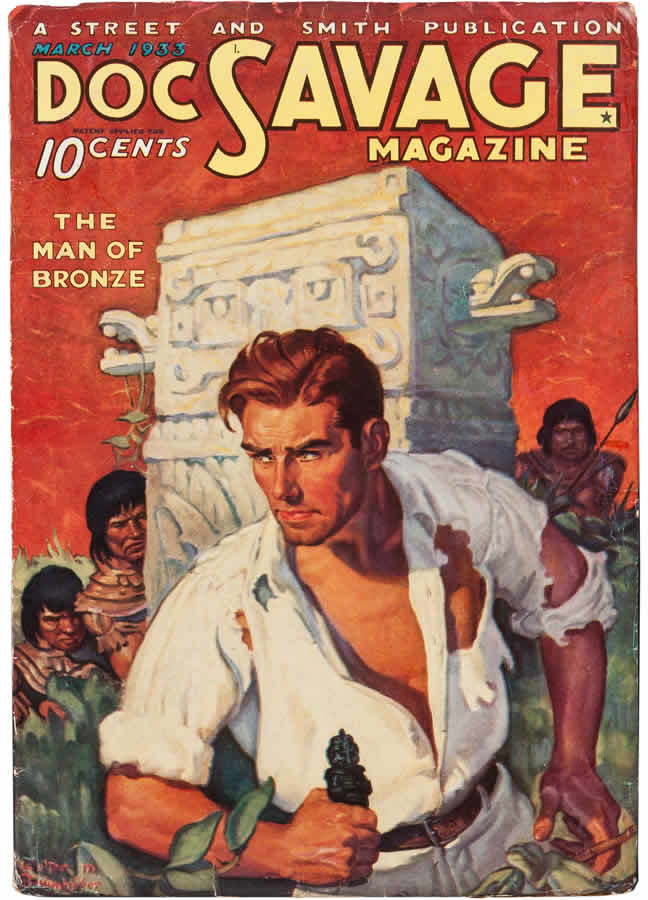
These early pulps often had very conservative, “proper” cover art, if indeed the covers had art at all – many were all-text declarations of the issue’s contents. Portraits of young women, particularly Broadway actresses, were a favorite, as were country scenes, landscapes, cowboys conducting general work activities, etc. Such titles, following in the wake of Argosy, included All-Story, Munsey’s, The Popular Magazine, People’s Magazine, Red Book, Blue Book, The Scrap Book, Cavalier, and others. Each issue provided a mix of fiction, often including westerns, romance, far-East or African adventure, and even some early science-fiction, all within the covers of a single issue.
In the late teens, and particularly into the 1920s, the “modern” pulp began to emerge. Authors began to specialize in the medium, especially those who could crank out dozens of stories a year and keep up with the demands of more and more specialized fiction. Argosy, Blue Book, and Popular continued to thrive, but many titles began to play toward a specific market. Probably the first genre-themed title actually began as early as 1906, with the introduction of Railroad Magazine. But the trend toward category-fiction did not really begin to ignite until a decade later. The first all-mystery and detective magazine, Detective Story, began in 1915, and by the ’20s attracted a large stable of now-famous pulp authors. Western Story premiered in 1919, and eventually produced over 1,300 issues. Black Mask saw its first issue in 1920, and only three years later would begin premiering an all-new American-born genre of fiction – the hardboiled detective story. Air Stories (1927) is considered the first aviation-themed pulp, a concept which would explode in popularity over the next few years, while North-West Stories (1925) remained strong for over two decades. The 1920s also saw the arrival of Amazing Stories, the ground-breaking first American science-fiction magazine, and Weird Tales, the hugely influential title devoted to horror and weird fiction. In fact, the specialized-fiction title became such a craze that some titles were simply too narrowly focused and doomed to failure. These, now exceedingly rare due to poor sales or distribution, included such oddly themed titles as Submarine Stories, Zeppelin Stories, Cabaret Stories, Harlem Stories and Co-Ed Campus Comedy.
Enlarge
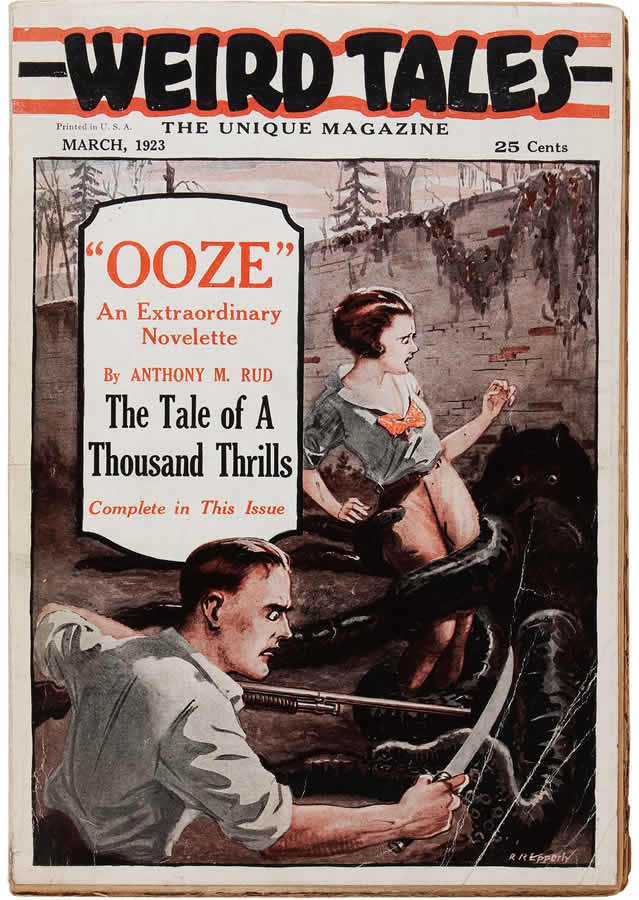
Enlarge
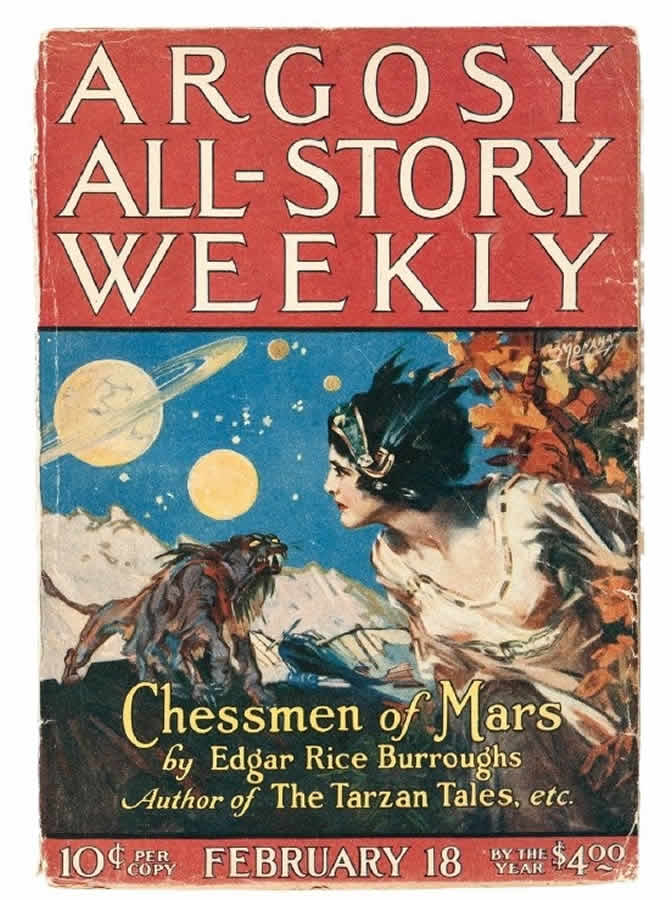
The 1930s, however, represent the undisputed golden-age of the pulp magazine. While many of the ’20s magazines continued to be successful, dozens of new titles, some popular and some short-lived, sprang up. Two of the most sought-after pulp genres among collectors today also took flight in the ’30s: the hero pulp and the weird menace/“spicy” titles. The hero pulp began in 1931 with the first issue of The Shadow, originally based on a radio program. It is considered the first pulp magazine devoted to the adventures of a single costumed hero. The first appearance of The Shadow is to pulp collectors what the first appearance of Superman is to comic book fans. And in fact, The Shadow’s influence on comic books is inarguable – though specifically he is one of the progenitors of another famous DC Comics hero … the Batman. Superman himself, however, was also heavily inspired by the pulps. The Man of Steel’s name, Clark Kent, was a conscious combination of pulpdom’s two greatest heroes … the previously mentioned Shadow (aka Kent Allard) and Street & Smith publications’ next powerhouse creation, the Man of Bronze Doc Savage (aka Clark Savage). Numerous hero-pulp competitors ensued, such as The Spider, G-8 and His Battle Aces, Operator #5, The Phantom Detective, The Green Ghost, and masked western counter-parts such as The Rio Kid, The Masked Rider, and even The Lone Ranger himself.
The Spicy titles were something altogether different. Whereas the hero pulps were produced primarily for adolescent males, the Spicy line was geared toward their fathers. There had already been a long history of somewhat raunchy fiction magazines with often provocative covers … titles such as Pep Stories and Breezy Stories had been around since 1926 and 1915, respectively. Dime Mystery has the distinction of creating what is considered the first “weird menace” issue in 1933, and clearly set the tone of the trend to come. Soon afterward, a publisher known under various guises as Culture, Trojan and Arrow not only followed suit, but devoted almost their entire stable of titles to the concept. The cutesy poses of cheesecake predecessors were replaced with remarkably vivid covers of half-naked women in surreal situations of terror and torment. Bondage, torture, fiendish villains and horrific monsters sent dozens of young females cowering in fear or running for their lives in cover after cover through the 1930s. Titles such as Spicy Mystery, Spicy Adventure, Spicy Detective and Spicy Western promised lurid tales of seduction and sensational adventure. Equally cruel and salacious covers decorated the issues of titles such as Horror Stories, Terror Tales, New Mystery Adventures, Saucy Movie Tales, and others.
Enlarge
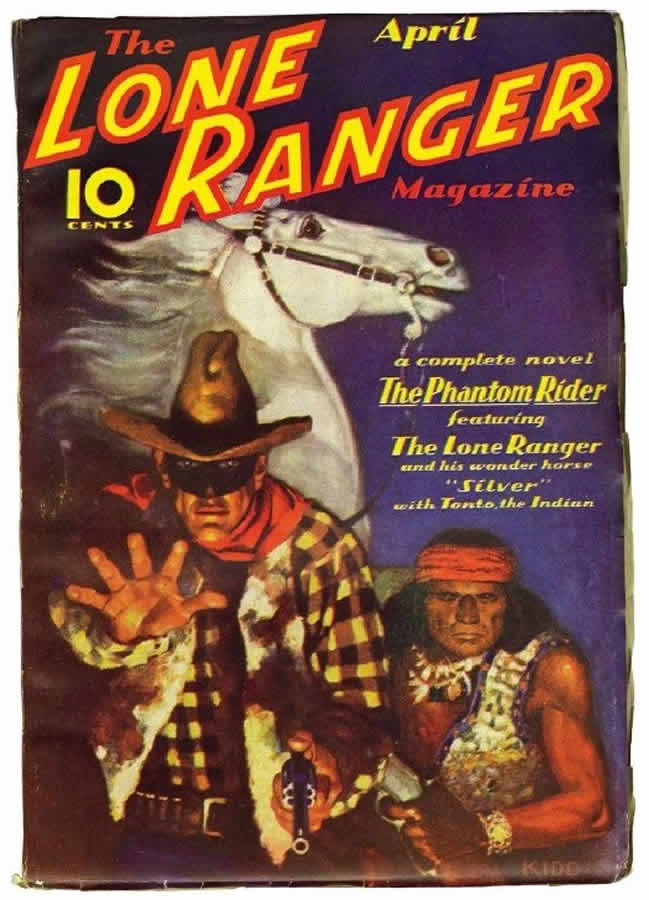
Enlarge
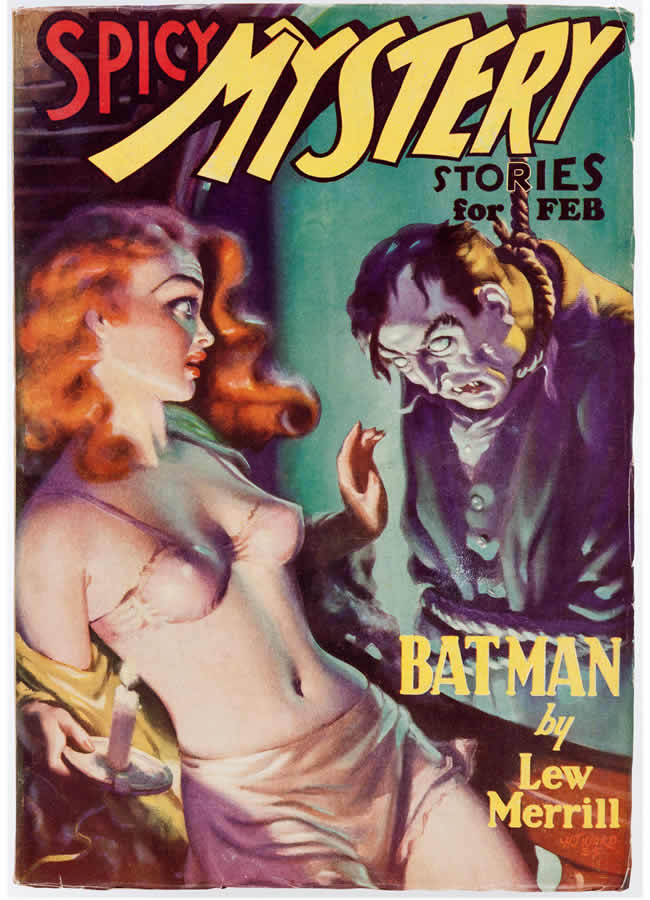
By the late 1930s, science-fiction entered its golden age. Beginning at Astounding, a new and more adult-themed approach to the genre emerged, and new talent debuted on an almost monthly basis, many of whom would dominate and influence the field for decades to come. Despite an uninformed mass-media’s continued derision of SF as “that crazy Buck Rogers stuff,” the genre explored all manner of topics from science and technology to religion, philosophy, and an array of topical social issues. Pulp science-fiction would thrive through the 1940s, in titles such as Astonishing Stories, Planet Stories, Future, Super Science Stories and Fantastic Adventures.
But the 1940s also brought the first hints of change to the pulp world. The modern-style paperback book saw its first significant mass-market release in 1939. War-time paper shortages had pressured many titles into thinner issues, and by the end of the ’40s, television would begin impacting other forms of escapist fare, pulps included. Street & Smith canceled its pulp format for many titles and moved into the smaller digest publications as early as 1943 and 1944. Certain titles remained strong, but many more started up and collapsed after only a few issues.
A few short years later, the classic “pulp” as we have come to know it would be gone. Most pulps still extant saw their demise in the mid-1950s, and those titles which continued shifted into digest format. The pulp story, of course, still existed … it just shape-shifted. Authors that would have been pulp stalwarts, had they appeared a decade earlier, saw success in the digests and paperback novels … Mickey Spillane, Harlan Ellison, Philip K. Dick, Jim Thompson, Michael Avallone, Harry Whittington … all worked in the post-pulp fiction marketplace. Some former pulp authors adapted and found different and sometimes greater success in the new mediums … John D. MacDonald, David Goodis, Day Keene, Evan Hunter, Louis L’Amour … found little difficulty in the transition as not only the magazine format changed, but audiences craved the complete novel-length work emphasized in paperbacks over either the short story or serialized pulp novel. And by the 1950s and 1960s, many of the old-time pulp superstars, some posthumously, saw new popularity in paperback reprints of their classic stories, such as Edgar Rice Burroughs, Ray Cummings, H.P. Lovecraft, Talbot Mundy, Max Brand and many others.
INFLUENCE OF THE PULPS
Though the majority of pulp authors have been forgotten by all but the specialized collectors of the field, a number of them impacted 20th-century literature like few others. Carroll John Daly, Dashiell Hammett, and Raymond Chandler took the detective out of the country manor and plunked him down in the middle of the rain-slicked urban morass. The hardboiled crime story not only changed the rules of the traditional detective narrative, but flavored literary dialogue with new spices, and probed the midnight streets and neon-flashed alleys of the Jazz Age with a smart-aleck cynicism.
New heroes rocketed to cultural superstardom from the pulps. There had been jungle-men before Tarzan, and his origin was certainly influenced by Kipling, but none before had so enthralled such a huge mass audience as Edgar Rice Burroughs’ creation. The new medium of motion pictures had a lot to do with this, as not only could fans read the original stories, but they now flocked to the cinemas to see Hollywood’s interpretations of the jungle lord, as well as Johnston McCulley’s Zorro, Hammett’s Sam Spade, Walter Gibson’s Shadow, and countless western serials and movies often adapted from the pulps. The aforementioned hero pulps were actually only briefly popular, surviving less than two decades, but they influenced an even larger medium, the comic book, and pulp-hero inspired films continue to be produced to this day. Other creations began with small cult followings in the pulps, and only years later achieved icon status, such as Robert E. Howard’s Conan or H.P. Lovecraft’s Cthulhu Mythos. And many major authors not often associated with that medium actually got their start in the pulps … Louis L’Amour, Isaac Asimov, Ray Bradbury, Mary Roberts Rinehart, Albert Payson Terhune, Rex Stout, Howard Fast, Tennessee Williams, Erle Stanley Gardner, to name just a few. And even Miss Marple, Captain Blood, and Horatio Hornblower saw some of their first American appearances in the pulp magazines.
©2019 Tim Cottrill, Ivy Press. Reprinted with permission.
Coming on Strong
NEWLY ENERGIZED CATEGORY PROMPTS FIRST PRICE GUIDE UPDATE IN 20 YEARS
Timothy Cottrill is owner of Bookery Fantasy, a “pop-culture mega-store” operating out of Fairborn, Ohio, for more than 35 years. This year, he is releasing in partnership with Heritage Auctions Bookery’s Guide to Pulps & Related Magazines: The Most Complete Pulp Data and Price Reference in Print. We talked to Cottrill about pulps and his guide.
EVENT
Heritage Auctions offered pulps in its weekly and Signature® comics and comic art auctions. Visit HA.com/comics for auction schedule. To consign, contact Todd Hignite at 214.409.1790 or ToddH@HA.com.
Enlarge

When did you personally get interested in pulps?
It wasn’t a matter of being specifically interested in them, at first. But they would show up in collections with vintage books, comics, etc. We opened in 1984, and you couldn’t just look these things up on the internet back then. So you had to check against dealer catalogs to try and ascertain how they were graded and priced. Information was erratic and incomplete. There was nothing like the guides available for comics, coins or cards.
Tell us about the background of your pulp guide.
As pulps – along with everything else – began to accumulate over the years, I would find varying prices in my own inventory, as mostly it was guesswork as to how to evaluate a given issue. By the late ’90s, I was gathering notes so that my own stock would be consistently priced and graded. I also began accumulating data on authors, pseudonyms, key stories, etc.
Enlarge
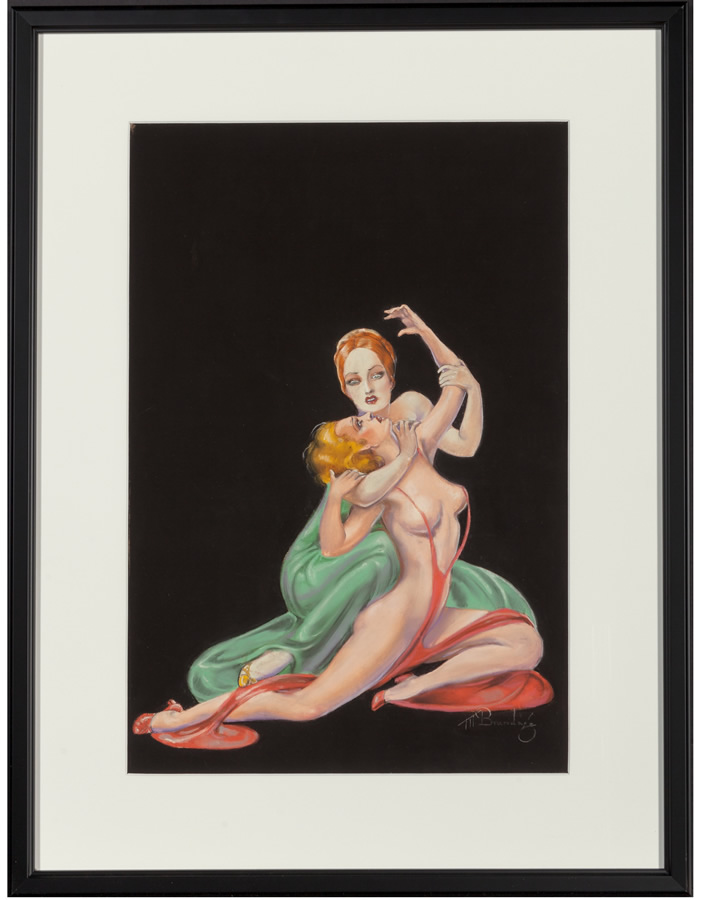
And that led to your first book?
In 2001, I published my first pulp guide. I had already done a library reference volume on science-fiction series with Garland Publishing many years earlier. The Ultimate Guide to the Pulps was formatted quite differently, and had some data gaps. But I kept gathering and refining information, and in 2005 released the first Bookery’s Guide to the Pulps. Now, 15 years later, it seems past time for a new edition.
What’s happening today with pulps?
More recently, pulps are being most noticed for their cover and interior art. Pulp art includes popular culture and exploitative elements that move beyond even that found in comics, movie posters and most paperbacks. While there is much traditional classical art in pulps, there are also hundreds of splashy, over-the-top, kitschy, and even bizarre covers that have come to be associated with the medium, and are now highly prized by collectors.
Are pulps relatively easy to find these days?
Pulps are more fragile and far tougher to obtain in high grade than comics, even golden age ones. And there are many individual titles (let alone issues) of pulps that are just plain rare … to the point where there are possibly some pulp magazine issues still to be discovered … an unlikely scenario with mass-market comics. All of these factors, historic significance, flamboyant and attractive artwork, and enough scarcities to make the chase exciting, have combined to drive the market for pulps forward, especially in recent years.
Hector Cantú
This article appears in the Spring/Summer 2020 edition of The Intelligent Collector magazine. Click here to subscribe to the print edition.

